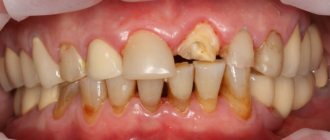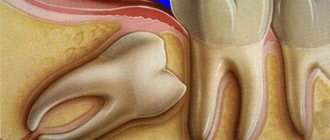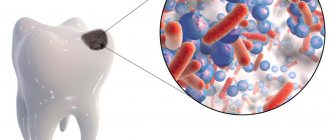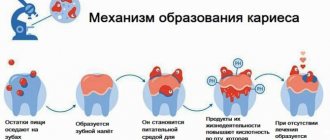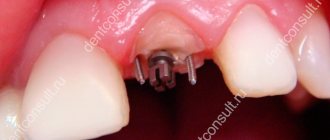- Dental crown - what is it?
- Types, materials, manufacturing methods and photos of dental crowns
- Time and stages of making dental crowns
- Lifespan of dental crowns
- How to best prepare for a visit to an orthopedic dentist
- Before visiting an orthopedic dentist
- At the dentist's appointment
- After prosthetics
- Which crown is better - metal-ceramic or zirconium?
- Common questions from clients
- About cheap dental crowns, advice
Dental crown - what is it?
A dental crown is a structure that replaces or restores the coronal part of a tooth.
By analogy, the crown can be compared to a soldier’s helmet. A crown on a tooth covers its upper part, like a helmet, on a soldier's head. A dental crown has three main functions:
- Aesthetic (visually retains an appearance indistinguishable from your own teeth)
- Functional (promotes chewing, as it is fully capable of withstanding and distributing the chewing load in full.)
- Protective (preserves the tooth’s own tissues from mechanical and carious damage)
Why do you need to cover (restore) teeth with crowns?
- Tooth decay is the most common reason for crowning. If the coronal part of the tooth is destroyed by more than 50% or the presence of circular caries, restoration of the coronal part of the tooth with an orthopedic crown is indicated. If this rule is not followed, unfortunately, within several years the tooth is destroyed and further restoration is not possible (the tooth will be removed).
- Depulped (nerves have been removed from the teeth) chewing teeth should be covered with orthopedic crowns to avoid chips and fractures of the walls of the crown part of the tooth. The thing is that when depulping (removing the nerve of a tooth), in addition to the nerve, the entire nutrient bundle is removed. In other words, the tooth does not receive nutrition and the materials used to fill the root canal have a strong drying effect on the tooth tissue, that is, they dry out the tooth, and therefore the tooth becomes very fragile.
- Aesthetic defects, such as dental discoloration due to fluorosis, enamel hypoplasia, tetracycline teeth, etc., require restoration through the manufacture of crowns.
- Injuries, in case of traumatic damage to the coronal part of the tooth (fracture, chipped tooth crown), there is often a need for restoration with an orthopedic crown.
- The need for total or partial jaw prosthetics. That is, if it is necessary to replace part of the missing teeth or correct dentofacial deformations, the supporting teeth are covered with crowns, which are part of bridge or splinting prostheses.
- Also, if we are talking about removable dentures, then the supporting teeth are covered with crowns to avoid mechanical damage from excess pressure from the removable denture.
Why depulpate teeth before dentures?
Before prosthetics, the dentist must grind (remove part of the dentin and enamel) the tooth by 1.5 - 2 mm (depending on the material of the future crown) around the circumference. It is impossible to maintain absolute sterility during this process, due to the fact that the oral cavity is not sterile. Therefore, by leaving your teeth “alive” you preserve microbes in your tooth, and over time (from several months to several years) the problem will make itself known and the tooth will have to be removed.
Habits that ruin your teeth every day
| Poor canal filling. If necessary, before installing a crown, the doctor removes the neurovascular bundle (pulp) and then fills the dental canals. If the canals are severely curved or the doctor does not have enough experience, then mistakes may be made during the procedure, which can cause pain in the tooth. These include:
It is important that before and after canal treatment the dentist takes targeted photographs - this is the only way to identify all the shortcomings | |
| Poor quality materials. Poor filling material begins to settle and does not adhere so tightly to the walls of the tooth, thereby eliminating the tightness. Sometimes the filling cracks, and through these micro-cracks an infection enters the tooth, which causes the development of caries under the crown. | |
| Perforation of the root wall. If the roots are severely bent, the doctor may not calculate the force of pressure on the drill. As a result, the channel is drilled through. If the error is not corrected, the infection can penetrate into the tooth from below and lead to caries. Perforation can also occur if the pin is not installed correctly. | |
| Fracture of the instrument in the canal. The disposable root canal drill is very thin and fragile. If the channels are strongly curved, then with strong rotation and awkward movement of the doctor, the tip of the instrument may break off. There are other reasons why a foreign body remains in the canal:
| |
| We recommend taking a panoramic photo of the jaw (OPTG) before installing a crown. It will allow you to timely detect deformation of the canals, the presence of inflammation and particles of instruments in the canal. | |
| Incorrect crown size. There are several reasons for this: an error during taking impressions; deformation of the material from which the impression is made; the crown was installed without fitting;; The dental technician did not correct the defects after trying on the crown. | |
| Error in crown installation. The crown does not fit tightly to the tooth, or it is installed without taking into account the bite - it can be too high or low - this injures the antagonist teeth. | |
Types, materials, manufacturing methods and photos of dental crowns:
In modern dentistry, metal-ceramic crowns and crowns based on zirconium dioxide are most often used.
Crowns such as solid-cast and stamped are made extremely rarely and mainly in cases where it is impossible or impractical to manufacture metal-ceramic or zirconium crowns.
- Metal-ceramic crowns
They are a combined crown, where the frame (cap) is made of metal, which is later covered with ceramic mass. Aesthetically and functionally, it is practically no different from your own dental tissues. - Crowns based on zirconium dioxide (zirconium)
They are a combined crown, where the frame (cap) is made of zirconium (in other words, a white mineral) which is later covered with ceramic mass. Aesthetically and functionally, it is practically no different from your own dental tissues. Zirconium crowns are more aesthetic due to increased transparency. - Temporary crowns (metal-plastic crowns)
They are made of either composite or plastic. These crowns are slightly inferior in beauty and strength to the above. But they have a huge advantage - they can be made in a matter of minutes right in the dentist’s office. They are used as an intermediate (protective) structure during the production of permanent crowns.
Time and stages of making dental crowns
To make permanent dental crowns, the dentist will require an average of a week and 2-3 patient visits.
- First visit The doctor conducts a functional analysis. Then the teeth are prepared (depending on the type of dental crown). Takes silicone impressions. Makes and fixes temporary crowns on prepared teeth. Determines the color of future teeth together with the patient. Discusses options for crown shapes.
- Second visit (after 7 days) Trying on the finished structure in the oral cavity. Fixation of the crown with double-hardening cement. If the shape or color needs to be adjusted, another visit to the dentist may be required. Metal-ceramic and zirconium crowns are made in a dental laboratory within 7-12 days (depending on the complexity of the work). More than 5 dental technicians are involved in the process.
We strongly do not recommend using advertising products “dental crowns in an hour”, etc.
Unfortunately, technically, modern CAD CAM systems do not reach the level that a dental technician can make (either aesthetically or functionally) the marginal fit of such crowns, and the aesthetic appearance does not stand up to criticism.
How to care for a crown
Both the dentist and the patient are interested in the crown serving its intended purpose for a long time. To increase the period of good functioning of the prosthesis, a person will need additional care products, because a standard toothbrush is not able to clean the removable element:
- The beam brush is designed to clean the internal surfaces of the prosthesis;
- The interproximal brush on the head contains a special brush that easily reaches hard-to-reach places on the lateral surfaces of the prosthesis, cleans the areas between the crown and adjacent teeth;
- Floss is required for regular cleaning of interdental crevices;
- If the household has an irrigator, it will be a constantly in demand device, because only it can clean the areas in the cervical fastenings of crowns.
Before visiting an orthopedic dentist
- Do not be nervous.
- Before taking (an hour), eat a hearty meal (the process of digesting food reduces strong emotional arousal).
- Try to plan your first visit to an orthopedic dentist for the first half of the day while it is light (only natural light allows you to accurately determine the color of your teeth), before the doctor is tired (we are all human, and in the first half of the day the doctor will pay you more attention and time than in the evening), while you not tired (the patient’s understanding of the process and all stages of treatment is very important).
- Collect all the photographs of your teeth that were taken before (regardless of the statute of limitations), this is often necessary.
- If you have old dental crowns or dentures, you should also take them with you.
Signs of tooth decay under the crown
The first thing the owner of a crown notices is bad breath. Brushing, rinsing, and flossing do not help eliminate it, or give short-term results. Manifestations other than odor:
- Mobility of the crown or tooth.
- Darkening of the visible part.
- Recession of the gums, exposure of the cervical area.
- Unpleasant, purulent taste in the mouth.
- Discharge of pus.
- Redness of the gums.
At the dentist's appointment
- Try to listen carefully to the dentist about possible prosthetic options. Do not hesitate to ask questions (your understanding of the treatment process is very important).
- Make a decision on one or another prosthetic option. Ask about the timing and total cost of treatment. Ask for a detailed treatment plan indicating the full cost, payment schedules and treatment time frames.
- Check the warranty period. Read the contracts carefully. If something worries you or you have doubts, do not hesitate to take a time out.
Remember! It is better to consult several doctors before starting anything.
Avoid! Promises and bravado, if you have previously consulted with several doctors and only one promised you what others refused, then we advise you to contact those who refused.
Carefully! If the clinic lures you into paying the full amount of treatment immediately REMEMBER that you will not get it back. Try to avoid clinics with this approach to taking money despite the discounts offered.
After prosthetics
- Before prosthetics, finally check the color and shape of the dental crowns in natural light. It’s better to go out into the hall and look in a regular mirror.
- Once fixed, it will be impossible to change the color.
- After fixing the crowns, try to spend some time in the clinic (for example, in the lobby), once again checking the structures in a more relaxed atmosphere.
- Ask your doctor about hygiene and special care practices.
- Ask for the doctor’s contact number (if necessary, ask questions by phone).
- Make an appointment with your doctor in 7 days for a follow-up examination, regardless of the condition of the crowns.
- Professional control is required after 7 days.
- If you experience any problems with your crowns, contact your dentist immediately.
Which crown is better - metal-ceramic or zirconium?
A bit of an incorrect question.
In terms of strength and aesthetic characteristics, these crowns are very close to each other.
On front teeth, zirconium crowns are more preferable due to their increased transparency.
But in the area of chewing teeth, we would not recommend using zirconium crowns due to the lower strength of the frame.
Therefore, the ideal option would be to use metal-ceramics in the area of the chewing teeth, and zirconium crowns in the area of the front teeth.
This cannot be done!
Often, in an effort to relieve pain, patients resort to rather risky methods. Remember what you should never do if inflammation starts:
- taking antibiotics without a doctor’s prescription - at best it will not bring results, at worst it will lead to serious health problems;
- warm the sore spot - elevated temperature favors the proliferation of pathogenic microorganisms, so such “treatment” will only worsen the condition;
- It is undesirable to take a horizontal position so as not to increase blood flow to the diseased tooth.
And finally, you should not let the situation take its course in the hope that the pain will go away on its own. It won't work! In order to get rid of pain, a doctor’s intervention or his recommendations are often necessary.
Common questions from clients
why do the gums darken near the crown??
- Error when preparing a tooth for a crown.
- Error in the manufacture of the crown (non-certified metals or the frame overlaps the ceramics on the outer surface).
- Root caries (a carious process has occurred under the crown), that is, the seal of the crown is broken.
- In all cases, urgent replacement of the structure is required. Failure to follow the recommendation will result in tooth extraction.
why does the tooth under the crown turn black??
the tooth has turned black - this is a symptom of tooth tissue destruction and requires immediate treatment. The dentist will remove the crown and evaluate the condition of the tooth. If a small part of the tooth has darkened, you can fill the tooth and make a new crown.
Is it possible to redo zirconium crowns? ?
Can. For example, if the color of the crowns is radically different from their own. In this case, the crown is sawed and removed without damaging your tooth.
Most often, it is impossible to change the color of the crown without removing it. Unless we are talking about some completely insignificant defect, which can really be eliminated by slightly tinting the porcelain.
If the discrepancy is really serious and very noticeable, the crown will have to be removed and re-fired in a dental laboratory. This is undesirable as it may change the density of the porcelain. In addition, only a crown installed on temporary cement can be removed and put back - when removing a prosthesis installed on a permanent basis, it can become irreversibly deformed.
Is it possible to change the shape of a zirconium crown??
Some changes in shape can be made if the crown is installed with temporary cement.
The ceramic on the crown chipped, why?
- Bruxism (teeth grinding).
- Technical shortcomings in crown manufacturing.
- Incorrect determination of occlusion by the dentist.
- In all cases, urgent replacement of the structure is required. It is impossible to repair high-quality ceramic crowns; replacement is required.
The crown fell out, how did that happen?
- Consultation with a dentist is required.
- If the crown falls out before a year after manufacture, most likely an error was made during prosthetics (subject to fixation with permanent cement).
- If many years have passed, then there are too many options, this requires immediate intervention from a specialist.
Double crown or two separately – which is better?
It is better to make a connected common denture for two teeth.
Why does the tooth under the crown hurt?
- In almost all cases, it indicates problems in the supporting tooth. Immediate consultation with a specialist (orthopedic dentist, therapist and surgeon) is required.
What to do to get rid of the smell
When an unpleasant odor occurs in the mouth, a person most often realizes that the cause is tooth decay, but tries to deal with the problem on his own: rinses the mouth with various pharmaceutical products or infusions made according to folk recipes, tries to kill the bad odor with mouth odorants or chewing gum. If the tooth responds with pain, the person takes painkillers. As a result, tissue decay continues. Then the pain goes away - because the nerve endings die, and the patient believes that a cure has occurred.
The result is tooth loss. It is especially unpleasant if the crown covered a gap in the front row. Now the patient will have to install an implant and crown to maintain the aesthetics of the smile. Therefore, no matter how great the temptation is to let things slide or attempt to cure yourself, remember: dental diseases, especially tooth decay under the crown, cannot be cured at home. All of them require the intervention of a medical professional.
Before visiting the clinic, you can rinse your mouth with tinctures of herbs that have anti-inflammatory properties: a decoction of chamomile, oak bark, calendula. In the hospital, the dentist will determine the stage of tooth decay and perform a series of appropriate procedures. A sick but strong tooth is cured, a damaged one is removed. If there is no inflammation, and the cause of the smell is plaque accumulated in the space between the tooth and the crown, the doctor will clean the tooth of dirt. The crown is then subjected to additional processing to adjust the size and ensure a tight fit to the stump. After this, the prosthesis is fixed with sealing cement.
To ensure hygiene in the oral cavity, if there are one or more dentures, a good solution seems to be the purchase of an irrigator - a device that removes dirt and plaque with a disinfectant solution supplied under pressure. Even hard-to-reach areas that no toothbrush can reach can be cleaned.
Dentists also recommend using dental floss and rinsing your mouth with clean water every time after eating. Various agents with an antibacterial effect are used to rinse the mouth. They are not able to clean plaque from microscopic cracks and gaps between the prosthesis and the tooth stump, but they successfully destroy pathogenic microbes, stopping their life cycle.
If the destruction of cement, loosening of the crown or weakening of the pin occurs during the treatment guarantee, then all actions to restore the quality of the prosthesis are carried out free of charge. Therefore, it is important for the patient to monitor the crown and, if in doubt, contact the clinic where the restoration was made in time.
Install veneers without grinding Luxneers teeth at Dr. Lopaeva’s clinic
Find out more about Luxneers
